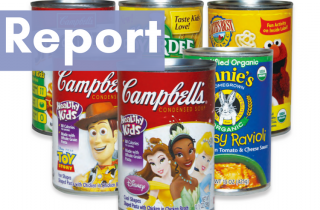No Toxics in Food Packaging
At a Glance
The No Toxics in Food Packaging Act would ban five chemicals or classes of chemicals linked to cancer or hormone disruption from materials that come into contact with our food, including handling, transport, bulk container, and final packaging materials. The bill is expected to be re-introduced and assigned a new bill number in the 118th congress.
Download the Fact Sheet
Overview
The No Toxics in Food Packaging Act prohibits the use of the following chemicals or classes of chemicals because of their carcinogenic, hormone-disrupting or other harmful properties.
- The class of Ortho-phthalates
- The class of PFAS chemicals
- Bisphenols (BPA, BPB, BPS, BPF, BPAF, & related compounds)
- Antimony Trioxide
- Styrene
The bill prohibits their use by amending the Federal Food Drug and Cosmetic Act to deem these chemicals unsafe for use as food contact substances.
Original co-sponsors of the bill: Rep. Eleanor Norton (D-DC), Rep. Nydia Velázquez (D-NY), Rep. Bonnie Watson Coleman (D-NJ), Rep. Raúl Grijalva (D-AZ), Rep. Stephen Lynch (D-MA), Rep. Pingree.
Background
Thousands of synthetic chemicals make up the materials that package and transport our food, from milking tubes to factory conveyor belts (on which food is transported during the manufacturing/processing stage) to retail packaging (i.e., sealings on jar lids, plastic containers), to cooking, food storage and serving ware. Chemicals from these materials can migrate into the food and our bodies, and some of these chemicals have been linked to negative health impacts ranging from allergic reactions to reproductive harm, learning disabilities, and increased risk of breast cancer.
In the USA, an estimated 5,000 chemicals are used in food processing and packaging materials, called ‘indirect food additives,’ with another 5,000 used as direct additives.
Over 200 chemicals on the FDA-approved list of food contact materials have been identified as hazardous, and another 530 would qualify for official hazard classification based on predictive hazard data.[1]
A growing body of scientific evidence is revealing the urgency of this problem as researchers and health practitioners sound the alarm on toxic chemicals in food packaging. In March 2020, an international group of scientists from multiple disciplines published a consensus statement expressing strong concern about harmful chemicals migrating into food from food contact materials, direct additives, and environmental contamination.[2] Before this, in 2018, the American Academy of Pediatrics issued a Policy Statement to draw attention to emerging child health concerns related to chemicals used in food contact materials and direct food additives used for preserving, coloring, or flavoring.[3] The 2020 Consensus Statement calls for known hazardous chemicals in any food contact articles to be prohibited.
Problem
The 1958 Delaney Clause of the Federal Food Drug and Cosmetic Act prohibits a chemical from being approved by the FDA for use in food if it is found to induce cancer when ingested by people or animals. Unfortunately, the FDA is poorly implementing and enforcing this clause, and chemicals that are well-established carcinogens or that may contribute to cancer risk through hormone disruption have been approved by the agency for use in food contact materials.
The FDA evaluates food chemicals for safety using outdated science,[4] particularly when it comes to hormone-disrupting chemicals, in understanding and applying their characteristics and contributions to hormonal cancers and other diseases. At the same time, the FDA does not conduct a program of systematic re-evaluation of chemicals that were approved decades ago to ensure it has considered updated science. As a result, toxic chemicals are legally on the market. These FDA failures mean that chemicals that are cancer-causing or hormone-disrupting (and thereby contributing to cancer risk) are in food contact materials in the US. A recent study found 189 substances that increase breast cancer risk are in food and beverage contact materials.[5]
Some of the most egregious examples are the chemicals and classes of chemicals that this bill would ban:
- Bisphenols (BPA and related compounds)
- Ortho-phthalates
- Per and Poly fluoroalkyl substances (PFAS)
- Styrene
- Antimony Trioxide
Solution
The No Toxics in Food Packaging Act bans Bisphenols, Ortho-phthalates, PFAS, Antimony Trioxide, and Styrene, deeming these chemicals unsafe in food packaging or processing materials.
- The bill applies to all food packaging, including reusable and pre-filled food and beverage containers.
- Once passed, companies would have two years to remove the banned chemicals from food packaging and processing materials.
- The bill addresses “regrettable substitution” – companies replacing a banned chemical with an equally or more toxic alternative.
- When assessing alternative substances, the FDA must explicitly consider the potential adverse effects of exposure on vulnerable populations, including pregnant women, infants, children, the elderly, and populations with high exposure, including workers exposed through production practices or handling of final products.
Endorsing organizations: 2023
BCPP supports this legislation along with national and state environmental and health NGOs and farming associations, including:
NGOs:
- Alaska Communities Against Toxics
- Alianza Nacional de Campesinas
- Alliance for Natural Health USA
- Bainbridge Island Zero Waste
- Black Women for Wellness
- Breast Cancer Over Time
- Breast Cancer Prevention Partners
- Beyond Plastics
- California Black Health Network
- California Environmental Voters
- Center for Community Action and Environmental Justice (CA)
- Center for Environmental Health
- Center for Food Safety
- Center for Public Environmental Oversight
- Clean Earth 4 Kids
- Clean Water Action
- Communities for a Better Environment
- Consumer Reports
- Defend Our Health
- Families Advocating for Chemical & Toxics Safety
- Friends of the Earth
- Friends Committee on Legislation of California
- Food & Water Watch
- Grassroots Environmental Education
- Green Science Policy Institute
- Hawai’i Alliance for Progressive Action
- Healthy Schools Network
- Iowa Breast Cancer Advocacy Network
- Jonas Philanthropies
- Last Beach Cleanup
- Long Beach ReUses coalition (CA)
- National Stewardship Action Council
- National Toxic Encephalopathy Foundation
- Organizing for Plastic Alternatives
- Pesticide Action Network
- Plastic Free Future
- Protect Our Breasts
- Public Employees for Environmental Responsibility
- Save the Albatross Coalition
- Save the Bay (San Francisco, CA)
- TEJAS – Texas Environmental Justice Advocacy Services
- Upstream
- Western Broome Environmental Stakeholders Coalition (NY)
- Zero Waste Washington
Farming associations:
- Maine Organic Farmers and Gardeners Association
- Northeast Organic Farming Association New Hampshire
- Northeast Organic Farming Association New Jersey
- Northeast Organic Farming Association Vermont
- Northeast Organic Farming Association Interstate Council
- Northeast Organic Dairy Producers Alliance
- Organic Farming Research Foundation
Businesses
- Kitchen Garden Textiles
- Mamavation
- Norumbega Strategies
- SALT Design Studio
- Tuft the World
- White Horse Coffee
- W.S. Badger Company
Press Releases
For more information, contact:
Janet Nudelman, Breast Cancer Prevention Partners, janet@BCPP.org
Footnotes
[1] https://www.foodpackagingforum.org/news/fpf-publishes-food-contact-chemicals-database
[2] Muncke, J., Andersson, AM., Backhaus, T. et al. Impacts of food contact chemicals on human health: a consensus statement. Environ Health 19, 25 (2020). https://ehjournal.biomedcentral.com/articles/10.1186/s12940-020-0572-5
[3] Trasande L, Shaffer RM, Sathyanarayana S. 2018. American Academy of Pediatrics (AAP) Council on Environmental Health. Food Additives and Child Health. Pediatrics. 2018 Aug;142(2). http://pediatrics.aappublications.org/content/pediatrics/142/2/e20181408.full.pdf.
[4] Muncke, J et al. 2017. Scientific Challenges in the Risk Assessment of Food Contact Materials. Environ Health Perspectives. 2017 Sep 11;125(9):095001. doi: 10.1289/EHP644. https://pubmed.ncbi.nlm.nih.gov/28893723/
[5] https://www.foodpackagingforum.org/news/food-contact-chemicals-among-921-substances-tied-to-breast-cancer-risk
Types: Article



